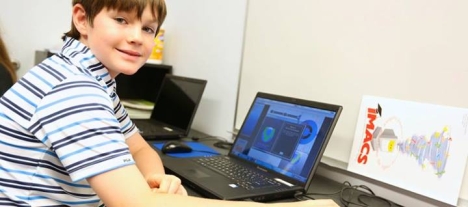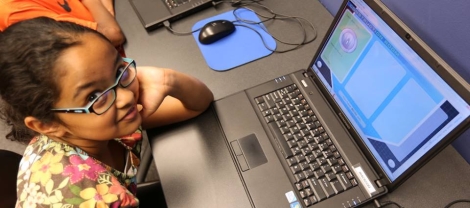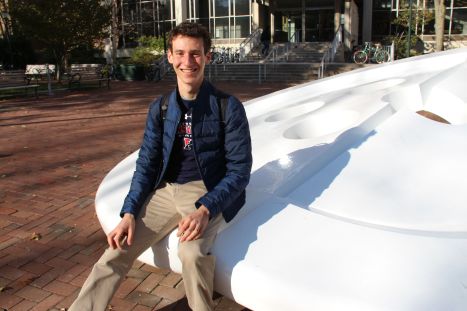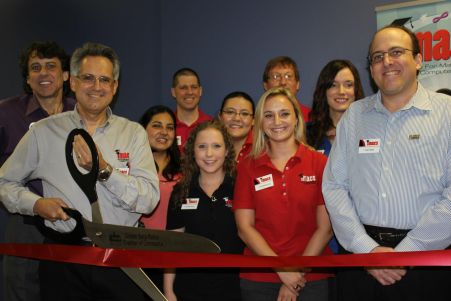
This year IMACS celebrates 20 years of educating talented, young students in mathematics and computer science. In all this time, we have never wavered in our philosophy that providing children with a deep and strong foundation in logical reasoning would enable them to take on virtually any intellectual pursuit with ease and confidence.
In mathematics, we continue to receive regular confirmation of our approach. Recent IMACS graduates often write to tell us of how advanced they are compared to their college math classmates, even at elite universities. Non-IMACS students who were so deftly skilled at applying formulas and algorithms in high school suddenly found themselves in college turning to our graduates for help in proving why these formulas and algorithms worked. It seems this phenomenon is steadily growing in computer science.
As strong advocates of K-12 computer science education, we are heartened by the broad realization that teaching children about this amazing and empowering field is of great importance. At the same time, IMACS urges parents, educators, and policy makers to understand the difference between coding and computational thinking, as well as the consequences of promoting one path over the other. As CS education decisions are made, we must not repeat the ruinous mistakes of math education policy lest we end up with computationally illiterate generation after generation as well.
Learning to Code Isn’t Enough
In a recent article titled “Learning to Code Isn’t Enough,” computer scientist Shuchi Grover offered the most articulate and convincing argument we’ve read on the shortcomings of the “learn to code” craze. In particular, Ms. Grover notes that the cognitive benefits gained through the process of good programming often fail to develop in online coding academies:
“Decades of research with children suggests that young learners who may be programming don’t necessarily learn problem solving well, and many, in fact, struggle with algorithmic concepts especially if they are left to tinker in programming environments, or if the learning is not scaffolded and designed using the right problems and pedagogies.”
“While the fun features afforded by these programming environments make for great engagement, they often draw away focus to the artifacts, many of which employ relatively thin use of computational thinking.”
The IMACS Approach
At IMACS, we have taken a considerably different approach to teaching computer science than the trendy, new organizations. Most importantly, we focus on universal thinking and problem-solving skills. That’s really what any programming exercise comes down to: thinking clearly about how to solve a particular problem. As Ms. Grover points out:
“If the goal is to develop robust thinking skills while kids are being creative, collaborative, participatory and all that other good stuff, the focus of the learning needs to go beyond the tool, the syntax of a programming language and even the work products to the deeper thinking skills.”
In our introductory computer science classes, IMACS deliberately uses programming languages that have trivial amounts of easily-mastered syntax. As a result, our students are able to concentrate their mental energy on learning the core concepts in computer science instead of on memorizing rules of syntax. Rather than focusing narrowly on ideas that only apply to a specific environment, IMACS classes develop computational thinking skills that can be applied to any programming situation.
Learning to Think with Logo
Children may begin taking IMACS Computer Enrichment classes as early as 3rd grade. Computer Enrichment uses Logo, an easy-to-learn language with a strong graphical component, to introduce students to programming ideas. Using a language with graphical components allows even our youngest students to understand and master advanced programming and problem-solving techniques.
IMACS Computer Enrichment places a heavy emphasis on computational thinking — thinking about logic, thinking about processes, thinking about good design. (All this takes place in a fun-filled class that incorporates interesting puzzles and problems.) A working program is not the main goal; rather, it is understanding how and why a program works or doesn’t. With a firm foundation rooted in computational thinking, IMACS students as young as 11 or 12 are well-prepared to move up to our university-level classes in computer science.
University-Level Computer Science
The IMACS curriculum continues with our Modern Computer Science track comprised of three university-level classes. The first course, UCS1, teaches the fundamental principles of computer science using Scheme. Scheme’s expressive yet simple syntax allows students to focus on learning universal concepts applicable in any programming language, even future languages not yet invented.
The second course, UCS2, begins in Scheme, but by the end students are programming in Haskell and Python. One reason that we introduced these additional languages into UCS2 was to show our students just how easy it is for them to learn new languages given their solid foundation.
The third course is our College Board-approved Advanced Placement Computer Science course in Java. This summer IMACS will be updating our APCS course with a new section on how to write Android phone apps. Although app development is not part of the AP Computer Science curriculum, the new component will allow IMACS students to gain experience in developing real applications.
The IMACS Advantage
While it sounds impressive to say that students who complete the entire IMACS computer science curriculum will graduate with significant experience in five diverse programming languages, what matters is that they leave us with something even more highly-prized: the ability to succeed in virtually any coding environment. Incidentally, whether or not IMACS graduates go on to study or pursue careers in computer-related fields, they gain an unfair advantage over their peers throughout their lifetimes thanks to their unmatched ability to dissect problems and articulate solutions. IMACS CS alumni, we look forward to receiving your emails.
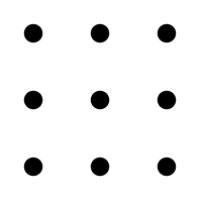 |
Can you link all nine dots using four or fewer straight lines, without lifting your finger and without tracing the same line more than once? |
We all understand what is meant when a person exclaims, “That’s so creative!” This is a typical reaction to a new and often pleasing, useful or clever idea. It might range from a musical composition to bionic limbs to proof of a longstanding conjecture in mathematics. Whatever the form, praise for the idea is rooted in its originality. Designed to be ever-learning, the human mind relishes new “food for thought,” and so as a society, we place a high value on creativity.
Books and blogs offer up a variety of tips on how to foster creativity. One piece of advice that is at odds with our experience at IMACS is the claim that logic stifles creativity. There is even a meme of Albert Einstein with the quote* “Logic will get you from A to B — Imagination will take you everywhere” posted frequently in support this misconception.
To the contrary, many students who studied our curriculum in mathematical logic have gone on to thrive in fields — puzzle and game design, teaching and medical research, just to name a few — that require creativity and logic. They succeed because they have a fundamentally superior understanding of what it means to think with logical creativity.
With respect to the cliché “think outside the box,” some consider logic as a villain that keeps creativity bound and gagged inside the box. As the argument goes, illogical ideas are either withheld or discarded too soon when they might have led to winning ideas, thereby hindering the creative process. But consider this quote on creativity by iconic creative force, Steve Jobs:
“Creativity is just connecting things. When you ask creative people how they did something, they feel a little guilty because they didn’t really do it, they just saw something. It seemed obvious to them after a while. That’s because they were able to connect experiences they’ve had and synthesize new things. And the reason they were able to do that was that they’ve had more experiences or they have thought more about their experiences than other people.”
— Steve Jobs, Wired, February 1996
“Creativity is just connecting things.” In our view, logic is one of the most powerful facilitators, if not the most powerful facilitator, of connectivity. Yes, logic will get you from A to B … and then to C … and to D and to E and so on, and that’s a good thing. Logic helps you think clearly about your knowledge and experiences, make connections among them and synthesize new ideas.
When learned well, logical reasoning has the power to unleash creativity. Build enough connections and you can follow a more direct path to the winning idea. You needn’t worry that the unstable bridge of an illogical idea was the only way you were going to get there.
*This attribution to Einstein has not been documented on Wikiquotes, not even as disputed or misattributed. Perhaps the meme is the result of creativity without logic.
| By drawing lines that extend outside the box formed by the outermost dots, one can find a solution to the puzzle at the top of this post. | 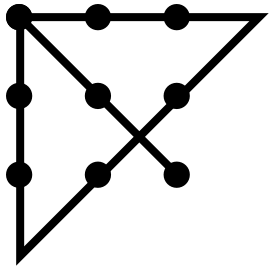
|
Developing good study habits before entering college is an essential skill that many gifted and talented children and their parents overlook. Some parents are often surprised to learn that their bright child can ace a schedule of honors or Advanced Placement courses with little studying. They might assume that if their child is receiving top grades in the most advanced classes offered by their school, he will be well-prepared to handle the rigors of university courses. This is an unlikely outcome without good study habits, and waiting until college to learn how to study is much too late when one might already be dealing with living on one’s own for the first time. Here are three tips to help foster this important skill while you still can.
Find a Challenge That Requires Studying
If a talented child attends school in a structured setting, chances are she is already being asked throughout the school day to cover material she already knows or can learn quickly. To ask her to take time at home to study the same material is to double her frustration. You’ll have greater success instilling good habits if you ask your child to study material that actually challenges her.
The experience may take some getting used to by both child and parent because, if done correctly, it will involve:
• A healthy struggle to understand new ideas,
• Getting less than perfect scores,
• Not always being the smartest kid in the room, and
• (Drum roll, please) having to study to do well.
Sometimes subject or grade acceleration can help, but parents should keep in mind that even with acceleration, a gifted child is still being asked to learn material that was designed for the way a typical student’s brain works. A better alternative to getting through standard curricula faster is to find an alternative that will encourage your child to understand subjects more deeply by addressing the “Why?” questions bright children are so naturally inclined to ponder.
Encourage a Growth Mindset
Stanford psychologist, Carol Dweck, is noted for her ground-breaking research on praise and motivation. She found that children who believed that a person’s intelligence was fixed tended to believe that truly smart people don’t need effort in order to succeed. By contrast, those who believed intelligence could be developed were much more likely to credit hard work as a key factor in achievement. (Going back to our previous point, Dweck also found that children who were praised for their intelligence instead of their effort were more likely to avoid challenges for fear of failing and losing praise.)
Dweck’s later research showed that children can be taught this growth mindset when educated on how the brain gets stronger and smarter through the process of learning. In this later study, students who were taught about brain development in addition to study skills outperformed those who were taught only study skills. The latter group was not motivated to put those skills to use. So parents, make sure your child understands the positive impact he can have on his brain and save your praise for the effort he puts into learning and studying.
Turn the Tables and Have Your Child Quiz You
One way to make studying more fun and give your brain cells a workout at the same time is to have your child test you. Turn the tables by being a student again with your child as the teacher. Have her create, administer and grade an exam that you take. Bright children often enjoy discussing and sharing their knowledge and may be more than happy to “show you up.”
In the process of creating the questions, your child reinforces in her own mind the concepts on which she will be tested. When grading, your child must go through the analytical exercise of determining whether your answers are correct and why incorrect answers are wrong. Even if you know the material well, be sure to throw in some wrong answers and ask for explanations of the right answers.
There is no simple solution for helping a gifted child develop the study habits he will need in the complex world of university life. However, should he find himself facing true intellectual challenges for the first time without this basic learning tool, he may be at a distinct disadvantage relative to his classmates, regardless of the natural ability that used to take him so far. Like most good habits, studying is one best formed at a younger age when behavior and attitude are more malleable.
It’s standardized stressing, um, that is, “testing,” season in the US again. Scores will soon be crunched, the debate as to whether they belong in teacher evaluations will rage on, and powerful and connected people will quote the results, no matter what they are, in support of their agenda. But regardless of what the numbers say, will outcomes actually improve for the constituency that this annual exercise claims to be benefiting, that is, the students?
Of course not. Worse yet, for all the dollars and time and energy expended by all involved, US students are worse off by many measures. Whether you ask at the university level or at the K-12 level, teachers lament the declining level of competency that students gain during their school experience.
I Passed the AP Exam and All I Got Was This Worthless Score
In February, American Public Media reported that several universities will no longer give credit to students who passed AP exams. More and more, professors are finding that even these students, who are typically advanced among their high school peers, are arriving unprepared to handle the rigor and complexity of college courses.
“[T]he general problem of college readiness ‘raises questions about whether the courses students took in high school, that might have been labeled AP or dual enrollment, were really providing students the preparation in writing and research that college itself will emphasize.’ ”
— Carol Geary Schneider, president of the Association of American Colleges and Universities
If you haven’t read the highly-publicized resignation letter from New York public school teacher, Gerald Conti, you really should. That a single teacher’s grievance on the destruction of his profession went viral tells you just how widely and deeply this topic strikes a chord.
“The development of plans, choice of lessons and the materials to be employed are increasingly expected to be common to all teachers in a given subject. This approach not only strangles creativity, it smothers the development of critical thinking in our students and assumes a one-size-fits-all mentality more appropriate to the assembly line than to the classroom.”
— Gerald Conti, Westhill High School
Now comes word that some states are rolling out new tests to meet the Common Core State Standards before the higher-level skills they require can even be taught. Should we expect anything other than a continued decline in US public school education when we are continually met with the same stuff, different decade?
Let’s Start at the Very Beginning — A Very Good Place to Start
What would it take for real reform to happen? First of all, time. You can’t just take older students who have been raised on weak curricula, throw a test requiring critical thinking at them, and expect them to respond well on any level. Critical thinking skills take time and experience to build, and the damage done by years of teaching to the old test cannot be undone in short order. This is especially true when teachers have neither the flexibility nor the training to teach critical thinking properly.
For meaningful and lasting reform to come about, deep changes need to start in the primary grades where minds and attitudes toward learning are most malleable. In US public schools, there has been a tendency for the brightest teachers to accumulate in upper grades where more complex subjects, larger bodies of knowledge and greater numbers of students require stronger teaching skills. These positions tend to pay more as well. On the face of it, this makes sense if you assume that teaching the skills of critical thinking, complex problem solving and abstract reasoning to younger children is less valuable. This is where our mindset as a nation must shift radically because, not only is imparting these essential skills to young children arguably more valuable, it takes incredible teaching talent to do it well.
Learn to Think, then Think to Learn
Why is teaching these skills at a young age so important? Because of all the good that would follow from children starting with a strong foundation. As any secondary school teacher will tell you, when a student arrives in class with these skills in place, teaching more complex ideas and larger amounts of information to that student is a breeze. He or she has a sense of how to gather and assess information, dissect and formulate arguments, and articulate thoughts clearly and effectively. Furthermore, he or she usually wants to learn because past experience hasn’t been one of yearly frustration, grade level after grade level.
Students who first learn to think subsequently use those advanced thinking skills to learn with significantly improved outcomes for the student. They learn more, and they learn more deeply. They feel greater confidence and control. The in-born love of learning is nurtured, which, along with higher-level thinking skills, serves these students well in high school, college and beyond. If you can envision the positive ripple effects through society of teaching this way, then you will understand why having more talented teachers at primary grade levels would be one of the most effective components of undoing the damage of high-stakes testing.
This month, IMACS chats with alumnus Daniel “Danny” Vidaud. Danny started taking IMACS math enrichment classes as an elementary school student and progressed through the introductory computer science class. He went on to earn his B.S.E. in Aerospace Engineering from the University of Michigan. Danny is currently in his third year as an engineer with Boeing.
Tell us about your current position at Boeing. What exactly do you do?
I am an aerodynamics engineer working in technology and product development. In a nut shell, I am part of the team of architects for the external shaping of future commercial jet airplanes. We spend our time sketching up new, outside-the-box ideas and bringing them to life!
What were you like as a kid? What kinds of things interested you?
I was a very intuitive child. Very not normal. Constantly absorbing as much as I could about the world around me. I had a tendency to quickly gain a functional understanding of complex ideas. The downside was that this only applied to topics I found interesting. A repetitive spelling assignment, for example, was as interesting to me as watching paint dry in an empty room with no windows. I needed to actively seek ways to challenge my inspiration or I would inevitably fall into a state of no motivation.
I enjoyed music. The piano, I found, was quite versatile at conveying a variety of musical ideas, but I hated studying it. I couldn’t stand the classical books or the structured process. The musical expression was inspiring; the structured training was not. Instead, I decided that mimicking what I heard on the radio was inspiring enough to practice for hours on end. Free improvisation and jazz composition became the new method of study.
Computer games! Fun! Not so fun when they freeze and get choppy, right? So I decided it would be interesting to develop a theory on what made a computer “fast” or “slow” and subsequently exploit that theory to help others in creating new systems or maintaining their old systems to do what they needed them to do.
Physics and all other things I found interesting went along the same lines of thought. The approach was always the same: Take a complicated problem, gain a general intuitive understanding for how it works, then generate as many permutations or original ideas as possible.
Did you know from a young age that you wanted to be an engineer?
Always. I didn’t always know it was called engineering though. I just knew that I liked asking the “Why not?” question a lot. “Why can’t we do something like this?” Challenging the normal. Being weird. It just seemed like more fun to not do what everyone else was doing.
Given that, rocket science seemed like a viable candidate. No one was doing it, everyone said it was impossible, and it seemed like it might be a good place to start if I wanted to get involved in something really complicated that may have high demand and low supply. So I turned 15, applied with a pre-declared major of Aerospace Engineering to the University of Michigan, a few years later developed a powerful network of friends, and then came to work for Boeing in the heart of its commercial think-tank.
How did your IMACS classes prepare you for college? Your position at Boeing?
The teaching philosophy for computer programming at IMACS is not the classical piano book approach. You will not become an expert at solving any kind of existing, well-defined problem with one specific and popular language. You’ll spend a lot of time not learning the computer language that you will be taught in your first term in college.
Instead, you will gather an understanding of what you might call “computer linguistics”. The ability to communicate an idea through the assembly of conceptual components. The skill of decomposing a multipart task into a simple abstract algorithm. At which point you are then free to cut code in the language that would be most efficient for communicating that idea. IMACS computer science provides you with a different way of thinking, not just an add-on to your résumé about how you can write code in an industry favorite language.
At Boeing, we spend time studying new functional aerodynamic shapes to solve a variety of complex problems while keeping in mind the multidisciplinary nature of every component. With every new idea, you walk through the development process to show that it’s viable, or even patentable. Some of the skills I learned at IMACS allow me to draft up a few quick and dirty scripts in languages I had never coded in before. This allows me to save a significant amount of time repeating similar analytical tasks on multiple candidate solutions or parsing out test data in a useful way. After IMACS, you become more comfortable interacting with the machine and make the most of the computational power you have available at your disposal.
You also have some experience teaching. What do you think the US has to do as a nation to improve math, science and computer science education?
I was a substitute teacher at a high school and subsequently a graduate teaching assistant in a first-year programming course for future engineers at Purdue University.
Successful college students today are very aware of the concept of perceived economic value. Students today are more likely to seek out business-related, social science or history degrees rather than physical science or engineering degrees. It demonstrates a general sentiment that the technical degrees are no longer worth their perceived cost (years and/or intensity of training, accrued financial burden, etc.). Science is not the “cool” thing to do anymore as it once was when scientists were in the limelight of the 60’s. The perceived benefit of being in a technical field was much higher. Marketing happened by default on the news every time a rocket launched at the NASA Kennedy Space Center. Unfortunately, the need for technical degrees is inherently difficult to quantify and isn’t always obvious at a cultural or global economic level anymore.
Today, we’ve come to take for granted the engineering and scientific leaps that have been made in the recent past, such as leaps in wireless data transfer, functional nanotechnology and intuitive human/machine interfaces. Advances in biotechnology research (e.g. replacement organs, spray on skin) have unlocked a new approach for healing the infirm.
Unless the general culture regains an appreciation for scientific exploration by raising the perceived benefits and reducing the perceived cost (as was once shown in the 60’s during the Space Race, or during WWI and WWII in aircraft and military weaponry development, or personal computer development in the late 80’s), we will see a general stagnation in “technological advancement” as it has been traditionally defined.
Traditionally defined innovation and scientific exploration is a high-risk, high-expense endeavor. It will only happen when the global market demands it and demonstrates its true value. When the free market price of oil is allowed to inflate beyond the point of affordability without manipulation, the economy will require immediate and immense creativity in alternative energy and fuel technology. The need for scientists and engineers will be made immediately relevant and the market support will demonstrate the true benefit to all who depend on that which they take for granted.
The traditional ambition within transportation advances, for example, in the past century has repeatedly contained the adjectives “faster, farther, higher”. On the ground we went from conventional rail to high-speed rail (e.g. France’s TGV) to magnetically levitated trains (e.g. Japan’s MLX01). In the air we’ve seen US Air Force-funded demonstrators like the Boeing X-51 flying multiple times the speed of sound over the Pacific Ocean.
It seems the general population is now fairly uninterested in the traditional. We are no longer actively pursuing this long-established goal. In a modern culture that is approaching one of perfect information (made possible, in part, by economically accessible, internet-enabled, naturally intuitive smartphones), we have the ability to make more rational purchasing decisions. Now the market tends to instantly reward those who can make a substitute product for a cheaper price. Engineering and science is being redirected to the practical. For example, after you pick your destination, travel websites will automatically sort by price. The name of the game now isn’t “faster, farther, higher” anymore. The commercial business case is just not there for it.
Social awareness is starting to flow into the demand for science and engineering. Privatized venture philanthropy and private humanitarian and community foundation efforts have created a multi-billion dollar industry in the past 10 years. Modern innovation is making commodities such as digitally-based financial services for the poor or basic health services available to the masses that were previously prohibitively expensive.
Science, Technology, Engineering and Mathematics are here to make the world a better place. How we each define “better” will guide innovation and large private capital into the directions that have highest economical demand and true value. The only thing we can do now is try to show the world what we are capable of accomplishing and what they can do as the culture begins to appreciate, once again, how powerful ideas really are.
This month’s guest blog post comes from Christopher Tiwald. Christopher studied the Elements of Mathematics curriculum from 6th to 9th grade as a student in Lincoln Public Schools in Lincoln, Nebraska. He attended the University of Nebraska-Lincoln where he majored in Political Science. After exploring a diverse series of careers, Christopher became a self-taught software engineer and now works at Conductor, Inc. as a Technical Operations Engineer.
spends time with one of his dogs, whose name is Bronx.
The most common complaint you hear from students in math class is “We won’t use this in the real world.” I’m ten years out of high school and six years out of college. I’ve made sandwiches professionally, waxed floors full-time, went to grad school, dropped out of grad school, and worked in professional politics. I can honestly report, “We were wrong.”
It turns out the real world doesn’t reward education as much as passion, self-starting, and the ability to solve problems. The Elements of Mathematics curriculum, or “Elements” as we called it in school, taught me how to learn. For four years I studied problems that bent my brain and stretched my imagination. They required every last modicum of creativity I could muster and, in truth, I wasn’t terribly good at them. I didn’t graduate top of my class — nowhere close. When I did graduate I vowed, “Never again”, and studied liberal arts instead of science in college.
But I couldn’t escape the Elements of Mathematics. Freshman Philosophy is a breeze when you’ve tackled deductive number theory. Supply and demand are trivial when you recognize their curves as simultaneous equations. College grades are driven less by raw IQ than they are by pattern recognition. Once you know how to solve one class of problems, it’s easier to solve again and again. It’s like the compound interest of education — compound interest, of course, being a concept I first encountered in Elements.
I thought it would stop when I finished college. Surely the real world, crammed full of unqualified positions, internships, and the entry-level, would not echo the Elements of Mathematics?
Did you know that if you have five ingredients to make a sandwich, the number of sandwiches you can make with two ingredients is exactly equal to the number you can make with three? Have you ever canvassed door-to-door for a campaign? The most efficient way to knock doors is often an Euler circuit — a route that takes you down every street exactly once. Here’s a fun one from the economist Thomas Schelling: Ski resorts are a closed mathematical system. The amount of time it takes to sit on the lift and wait in its line are inversely dependent. If you make the lift faster, you make its lines longer, because the time people take to ski down the mountain or warm up in the lodge won’t change.
You don’t need to know these things to run a sub shop, win an election, or enjoy a winter vacation, but knowing them gives you a more thorough, practical understanding of the world, one that is immediately useful to employers and in daily life. You learn new concepts quickly because you learned how to learn. You solve problems more efficiently because you’ve solved thousands of similar problems before. The Elements of Mathematics is a competitive edge without qualification. Bosses love it as much as professors.
As for me, I wouldn’t be who I am without the program. Elements changed the way I interact with the world. After wandering from career to career, I landed comfortably in software engineering, something I taught myself. That says less about me than it does my education. All jobs are strings of solvable problems. Once you’ve learned how to think, the rest is easy.
“The obsession with arithmetic skills that characterizes so many elementary curricula is indeed curious. Consider an analogous situation: No one would ever suggest that the be-all and end-all of the school English curriculum is proficiency in spelling. … It would not occur to anyone to argue that a child who has not first mastered spelling should be denied the right to read and write. … Of course, we must also be concerned with spelling, but we are not obsessed by it. The spelling will come, and surely come more easily, if children enjoy and appreciate the uses of language.”
From “Mathematics Education: A Humanist Viewpoint”, Braunfeld, Peter, Burt A. Kaufman, and Vincent Haag, Education Technology, November 1973.
If you read the guest blog post by IMACS alumnus, Steve Krouse, the following sentence may have resonated with you, either as a memory from childhood or as a more recent parenting experience: “The summer after 8th grade I took Algebra II to catch up in math (a subject I despised only a few years prior because of my failure to perform in arithmetic timed tests).” Thankfully, Steve found his way and is doing well in college today.
But why do some mathematically talented children, who perform exceptionally well in untimed situations, have difficulty with timed arithmetic tests? More importantly, how can we help these kids?
A good first step may be to let these children know that their intelligence is not in doubt because such tests are hardly good indicators of mathematical ability. Rather their primary aim is to measure how many facts a student can recall correctly within a finite period. After all, a student who can memorize and regurgitate math facts is not necessarily able to understand the reasoning behind those facts. Further exacerbating the issue of speed is the fact that in answering an individual problem a student begins by reading the problem and ends by writing the answer.
Just looking at the structure of the tests themselves points to three possible reasons why some bright children perform poorly on them. One might be the repetitive nature of timed tests—you have to do many of the same kind of problems, over and over. When gifted children are asked to do a repetitive task their minds often wander to more interesting thoughts. (And for a child, there are so many fascinating ones from which to choose!) Any resulting score or grade will seem low and out of sync with the child’s natural abilities.
When this happens, why don’t people think “That’s a natural outcome” instead of “That child needs to focus”? Surely you have been obligated to attend a function (e.g., industry conference, religious service, etc.) that was of little or no interest to you. It’s very likely that your mind, gifted or not, “strayed” to more engaging thoughts. Was this a definite sign that you are unable to focus? No. And the same is true for a bright child whose mind wanders away from a bunch of monotonous arithmetic problems.
Another explanation may be the speed at which the child reads, comprehends, and solves each question. Contrary to popular misconception gifted children can, in fact, be slow processors. Others may be perfectionists who go over each problem multiple times to avoid getting wrong answers. Some may be visual-spatial learners who would do better with shapes instead of numerals. Besides, we all know high-functioning adults who are slower at some things and faster at others. How does the slow-processing child grow into the successful adult? Chances are, someone along the way helped that child redefine slowness as carefulness and focus on a career field where carefulness is highly valued.
Finally, a timed test taker must write the answer to each and every problem on the page. This requires significant fine motor skills. For younger children, fine motor skills are often still developing. For gifted children of any age, their thoughts sometimes outpace their fingers thereby causing frustration that can interfere with clear thinking. Again, some may be perfectionists who want the numbers to look just so. Why can’t these students be allowed to give answers orally or type them on a keyboard? Sometimes, you wouldn’t know that we live in the 21st century with the way tests like these are still administered in some schools.
There are certainly other reasons why a mathematically talented child may not perform well on timed arithmetic tests. Organizations like the Davidson Institute for Talent Development provide a wealth of information such as this article on the topic. Whatever the reasons, these kids should be helped by the adults around them to understand that low performance on such tests are neither a measure of math ability nor a predictor of future success. We owe it to them to keep unhelpful and sometimes debilitating barriers out of their way on the path to excellence and high achievement.
It’s that time of year when we think about changes and improvements for the new year. Here are three that IMACS would be delighted to see on every educator’s list:
Teach computer science. The opportunity for American students to learn this increasingly important subject in school is woefully rare. If we want future generations to continue to have a high standard of living, we must prepare them for the jobs of tomorrow. While some of these jobs may not even have been invented yet, we are fairly certain that computational thinking learned through studying computer science will be a highly valued skill needed to succeed at them.
Be a guide, not an answer key. Give students time to puzzle through new concepts and problems and the opportunity to discover answers for themselves. Step in when needed to help avoid frustration. More learning will happen, more knowledge will stick, and more confidence will build for the next challenge.
Give children more unstructured time. This is such a challenging goal in today’s busy and competitive world, but it is well worth the effort. Our culture and history have long emphasized industriousness and productivity (for good reason), but we are now coming to understand that unstructured time is also a highly productive time for our brains. These are the moments when insight and unconstrained creativity lead to new ways of thinking and solving problems. Those are the seeds of progress.
Thank you all for a terrific 2012, and best wishes for a wonderful 2013!
This month’s IMACS blog post is by guest author and IMACS alumnus, Steve Krouse. Steve recently sent us the following letter via email and kindly agreed to let us share it with our blog readers. If you would like to learn more about the IMACS Computer Science program that was the turning point in Steve’s academic career, click here.
hangs out by "The Button" on the University of Pennsylvania campus.
Dear IMACS,
I’ve been meaning to write this letter for a while now. I’d appreciate it if you could forward it on to Ken [Matheis, Senior IMACS Instructor], who especially helped me become the student I am today.
As you may remember, I was a student at Pine Crest School when I started taking computer enrichment classes at IMACS. I was a pretty awful student in 6th grade. Seventh grade was even worse for me. I got a C in science, B’s in math and blamed my teachers for my academic shortcomings. Around 8th grade I started Scheme, and that’s when things started to click for me. It is often said that to really learn something, you need to teach it. I would argue that computer science allows you to learn things incredibly well because you aren’t only teaching something, you are teaching something to a computer. And when “teaching” computers, you have to be specific, organized and precise.
Computer science changed the way I thought about everything. It helped me organize my thoughts, improved my grades in every subject in school and made me a happier person. IMACS not only gave me a better organized thought process, but it gave me the confidence to take on more and more challenging academic endeavors. I remember the two week period I walked around school in a daze, desperately trying to solve the infamous Scheme problem, “Spin Cycle”, as the first time I was proud of an academic achievement.
I received straight A’s in 8th grade and got the award for the best science student in my grade (a far journey from a C in science the prior year). The summer after 8th grade I took Algebra II to catch up in math (a subject I despised only a few years prior because of my failure to perform in arithmetic timed tests). I received a 99% in the class. In high school, I got straight A’s, a 2340 on the SAT, a 35 on the ACT, received the MIT Book Award my junior year and the Math Career Achievement Award my senior year.
This year is my freshman year at Penn Engineering. I am very happy to inform you that I am the single most advanced freshman in the computer science curriculum at Penn. To illustrate it differently, after next semester, I will have only 2 classes left to complete the core requirements in my computer science major. I guess I’ll get to take a lot of grad school courses and electives. 🙂 Although I haven’t gotten grades back yet, I can report that I have received all A’s so far in my classes, which are: Data Structures and Algorithms, Introduction to Computer Hardware, Introduction to the Theory of Computation, The Art of Recursion, and Introduction to Legal Studies (for a little break).
I’d like to tell you about The Art of Recursion for a moment. My classmates in this class are juniors, seniors and grad students. They have interned at Microsoft, Facebook, and many other high profile tech companies. Two of them even teach courses in computer science at Penn (iPhone Development and Introduction to Python). And as you can imagine, I am totally rocking this Haskell-based course with my IMACS background. I am happy to report that I just got an A+ on the midterm.
I am so incredibly grateful to all of you at IMACS for helping me get to where I am today. I honestly could not have done it without you guys. Your curriculum for education in math and computer science is a model for every educator to follow.
Thank you,
Steve Krouse
August 29, 2012 of IMACS’ new Boca Raton learning center.
Our regular blog postings will resume next Thursday, November 29th. In the mean time, here’s a little list of things we are thankful for at IMACS.
• We are thankful for our incredibly talented and passionate instructors who, on a daily basis, inspire so many bright, young people to achieve great things.
• We are thankful for our tireless and dedicated staff who are what holds this institute together and allows us to accomplish so much.
• We are thankful for our ingenious curriculum developers whose boundless creativity and innovation never cease to amaze.
• We are thankful for our partner schools who embrace our vision and invite us to be part of their students’ educational journey.
• We are thankful for our supportive parents, all of whom make varying sacrifices to give their children the opportunity to learn with us and who entrust them into our care.
• Most of all, we are thankful for our amazing students whose pure joy in learning is an endless source of energy and motivation for all of us at IMACS.
To all of our blog readers, IMACS wishes you and your families a warm and happy Thanksgiving!
« Newer Posts — Older Posts »







